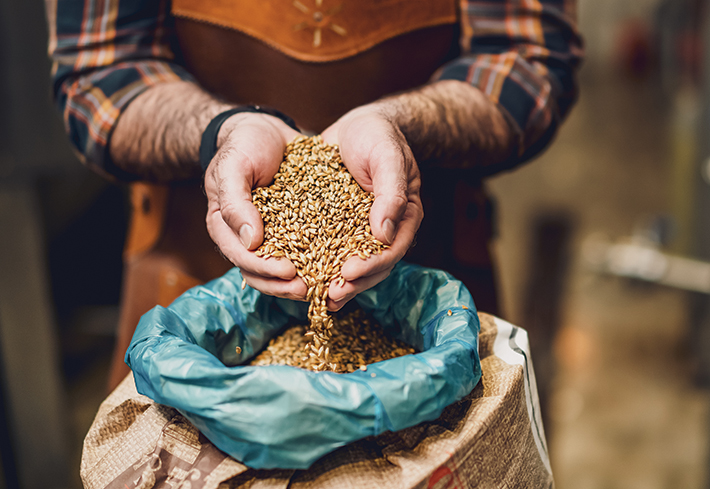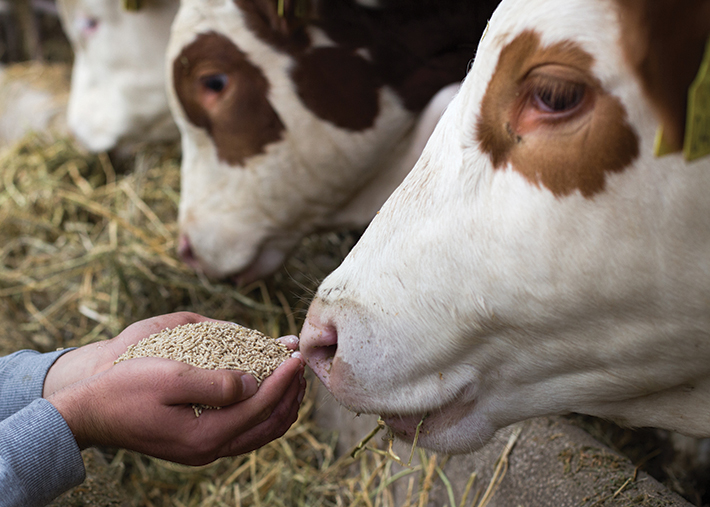
A Partnership for Distillers Grains Testing
Consult the World Economic Forum, U.S. Chamber of Commerce Forum, or Harvard Business Review and you’ll find similar information: Consumer interest in sustainability continues to grow. As people think more about the waste and byproducts created by what they eat, drink, and use, they could easily overlook distillers grains. These cereal grains are the co-product, or planned and beneficial byproduct, of alcohol and ethanol production.
In North America, corn serves as the basis for ethanol, but wheat, sorghum, and barley may also be utilized. According to the Iowa Renewable Fuels Association, one acre of corn produces 475 gallons of ethanol and 1.5 tons of distillers grains. The Renewable Fuels Association (separate organization) announced that in 2023, the United States exported 10.8 million metric tons of this co-product, at a value of $3.3 billion, to more than 50 countries. At that time, the global market size was valued at $11.5 billion. Continued growth is anticipated, with market size predicted to increase to $17.7 billion by 2032.
The history of distilling goes back to the Middle Ages, and humans have pondered what to do with the spent grains created by the process ever since. Rich in fiber, protein, fat, and minerals, distillers grains eventually became food for animals. The first recorded use of distillers grains in U.S. cattle feed dates back to 1907. By the 1990s, pigs and chickens began to consume it as part of their diets, too.
READ MORE: Grain Power
What is so attractive about this co-product? Costing up to 25 percent less than the price of traditional corn, distillers grains possess triple the amount of corn’s nutrients, making them an inexpensive source of energy and protein as well as part of a sustainable food-production system.
Terrestrial animals aren’t the only ones consuming distillers grains. Starting in the 1940s, researchers began testing it on aquaculture. Numerous studies indicate that the co-product is a phosphorus-rich, high-protein, cost-effective replacement for fish meal and soybean and wheat meal. It appears to boost fish growth and may increase immune-system responses.
For approximately a decade, the U.S. Grains Council has worked in Southeast Asia’s aquaculture industry to promote the use of distillers grains in tilapia and pangasius diets. The nonprofit Council concentrates on developing export markets for U.S. barley, corn, sorghum, and related products.
What livestock eat matters to producers and omnivorous consumers, as the animals’ diets directly impact what producers sell and what people ingest. Variability in the contents and quality of distillers grains can affect the animals’ health and their profitability. Mycotoxins are of particular concern. These toxins come from fungi that grow on corn and cereal grains, among other crops. In high doses, they can cause severe illnesses, such as autoimmune disorders, cancer, and death. Because mycotoxins cannot be discerned by sight, taste, or smell, accurate laboratory testing of this valuable consumable is crucial.
Proficiency Testing of Distillers Grains
Reliable, consistent methods and results are the goal when it comes to testing. To ensure that safe, quality co-products are used in animal feeds, the Distillers Grains Technology Council (DGTC) and ASTM International’s subcommittee on distillers co-products (E48.D0), part of the committee on bioenergy and industrial chemicals from biomass (E48), are collaborating on a proficiency testing program (PTP). A PTP is a statistical quality-assurance program that allows laboratories to evaluate their testing performance by comparing their results against other participating labs. The program verifies that manufacturers and research facilities are getting impeccable results from labs, and identifies ways that faulty labs can improve their performance.
In the case of distillers grains, the program addresses inconsistencies in test results and variability in the testing of distillers dry grains (DDG) and distillers dry grains with solubles (DGWS). The latter are dry grains to which the concentrated dissolved solids from the fermentation process have been added back.
Released in March 2022, the distillers co-products PTP applies only to dry grains. DDG have a moisture content between 10 and 12% and an indefinite shelf life. Distillers wet grains (DWG) and DWGS have a moisture content of up to 70% and a maximum shelf life of five days.
The DGTC and ASTM
For those unfamiliar with the DGTC, the nonprofit provides technical and educational services to the fuel ethanol, beverage alcohol, and livestock industries and their affiliated organizations. As its website states, the DGTC acts “as the principal voice on nutrition, safety, and regulatory issues affecting the production and use of distillers grains.”
When contemplating with whom to work on this new PTP, the DGTC considered who would be the best partner from a deliverable standpoint, says Dr. Joseph Ward, executive director of the DGTC. He notes that, as a leading global standards-development organization, ASTM was uniquely positioned as a reputable partner. Prior to its association with ASTM, the DGTC had been the sole administrator of the distillers co-products PTP.
Once the two formed the partnership, a few tweaks were made. At present, the PTP participants receive three distiller’s co-product samples for laboratory analyses two cycles per year. These testing cycles occur in March and August. Starting in March 2025, the program will change to one distiller’s co-product sample analyzed three cycles per year. This schedule will be more representative of real-world testing, Ward says.
“Three samples are kind of overkill,” he says. “When you’re in a laboratory, you select a good representative random sample from whatever you’re testing, you run the analytical tests on that one sample, and report the results. The PTP program mirrors real-world testing.”
The PTP works as follows: Labs analyze the submitted sample and record the data, which ASTM and the DGTC then evaluate. The organizations look at how the labs perform the measurement of compositional analytes such as protein and fat, physical properties, and the presence of mycotoxins. They identify any possible issues, determine how they can be remediated, and aim to improve lab performance. Ultimately, they want the PTP to establish confidence in the performance of all labs, whether they are in-house or third-party testing facilities.
“Partnering with ASTM was probably the smartest thing that the Distillers Grain Technology Council did,” Ward says. “We’re now doing a much better job of communicating with participants, identifying test result issues, and reporting the test results back to the participants in a timely manner.”
Diligence in Testing and Reporting
When distillers grains are shipped, the product analysis should be the same for both the producer and buyer. Yet, this may not always be the case.

Rich in fiber, protein, fat, and minerals, distillers grains eventually became food for animals.
“One of the things about lab work is that, just because you get a number, that doesn’t mean the results are a correct representation of the sample that was analyzed,” Ward says. “If you have an analytic company that modifies a testing procedure, doesn’t realize how that changes the values, and doesn’t reference the modification in the results, you start to question everything they’re doing. You really get into the weeds.”
Something as simple as not having a uniform particle size in a sample can skew results. Some grains co-products vary considerably in particle size. If they’re not ground to a uniform particle size prior to analysis, the results may not be an accurate reflection of the analyte tested.
When it comes to analyses performed using near-infrared spectroscopy (NIR) versus wet chemistry, a representative calibration curve must be used for the NIR-tested samples, Ward says. Otherwise, the test results may not be accurately reflected in the analyte tested.
“There can be a lot of differences in the manufacture of the distillers’ co-products between the beverage industry’s co-products and the ethanol industry’s co-products,” he says. “Our goal is to provide a program so that, whether you are testing using NIR or wet chemistry, the laboratory results are presentative of the test sample.”
Diligence is also needed when recording data. If a client’s measurements are units per kilogram, the data should be presented as such and not as parts per million or another form of measurement. Even the smallest error can prove detrimental to the seller and buyer. This is why the PTP and standard test methods are so important for distillers co-products—people need accurate results that truly reflect the co-product.
“We all need to be on the same page and hold labs accountable to follow the procedures,” Ward says.
Harmonizing Methodology and Standards
In its first year, the PTP received almost 50 sample submissions from third-party labs, ethanol manufacturers, and distilling plants. In the second year, it received 100. This was a major milestone, says Bart Plocher, vice president of quality at POET Bioprocessing. POET is the world’s largest producer of biofuel and a global leader in sustainable bioproducts.
FOR YOU: Standards Help Grow Agriculture
To be successful, the PTP needs increased participation. Plocher cites the ethanol proficiency testing program as his benchmark. It has around 200 participants and considerably more data. The subcommittee on distillers co-products encourages increased involvement as well as membership in E48.D0. It welcomes global industry and laboratory input as it considers what the best test methods are and whether any should be modified for DDG.
“There is a huge opportunity to harmonize analytical methodology for distillers grains and say, ‘This is how we’re going to measure fat.’ ‘This is going to be how we measure protein.’ And to put some standards in place,” Plocher says. “Hopefully, we’ll have somewhat of a cyclical loop where the program determines where the data is strong in certain areas and weak in others, and we’ll focus on standardizing the weak areas.”
Both Plocher and Ward note that with DDG, there is low-hanging fruit to address, such as moisture and how it’s tested and managed. Moisture appears in other calculations, so if a lab gets the initial number wrong, subsequent numbers will be incorrect, too.
Once the subcommittee gets more traction in its upcoming meetings (December 2024, June 2025), Plocher says it will start to discuss the creation of standard test methods for distillers co-products. The few standards that exist aren’t product-specific. Additionally, due to technology variation in the industry, standards will need to be vetted by the subcommittee against several variations of products that use similar label names.”
As for why standards are necessary, he points to consistency in marketing. “When you’re operating in a commodity space, customers want to know what they’re getting. They have expectations,” Plocher says. “As we work to establish DDGs more consistently in the marketplace, trying to benchmark those expectations and reference a standard method are critical to the industry. A customer can say, ‘I’m familiar with this standard. I know what this means.’ More consistent specifications build customer confidence.”
Long, Exciting Road Ahead
Looking ahead, the subcommittee anticipates an increased focus on mycotoxin testing. A longstanding food-safety issue, mycotoxins have become an even greater concern as DDG exports increase. Another aspect of testing to be discussed is NIR. Ethanol producers’ labs commonly rely on NIR to analyze samples and then cross-validate the results with wet chemistry to ensure the data is accurate. Ultimately, the subcommittee will evaluate all DDG test methods to determine which is the best for plants and laboratories to employ.
Although the subcommittee does see working on distillers wet grains in the future, for now, it will attend to the DDG and DGWS needs. “Our mantra,” says Ward, “is ‘We’re going to work on this and get it right.’”
For additional information or to join the ASTM and DGTC proficiency testing program and the subcommittee on distillers co-products (E48.D0), contact the staff manager for committee E48 on bioenergy and industrial chemicals from biomass, Brian Milewski at bmilewski@astm.org. ■
Kathy Hunt is a U.S. East Coast-based journalist.
 SN Home
SN Home Archive
Archive Advertisers
Advertisers Masthead
Masthead RateCard
RateCard Subscribe
Subscribe Email Editor
Email Editor